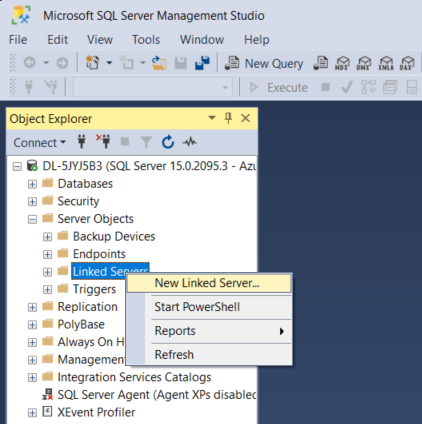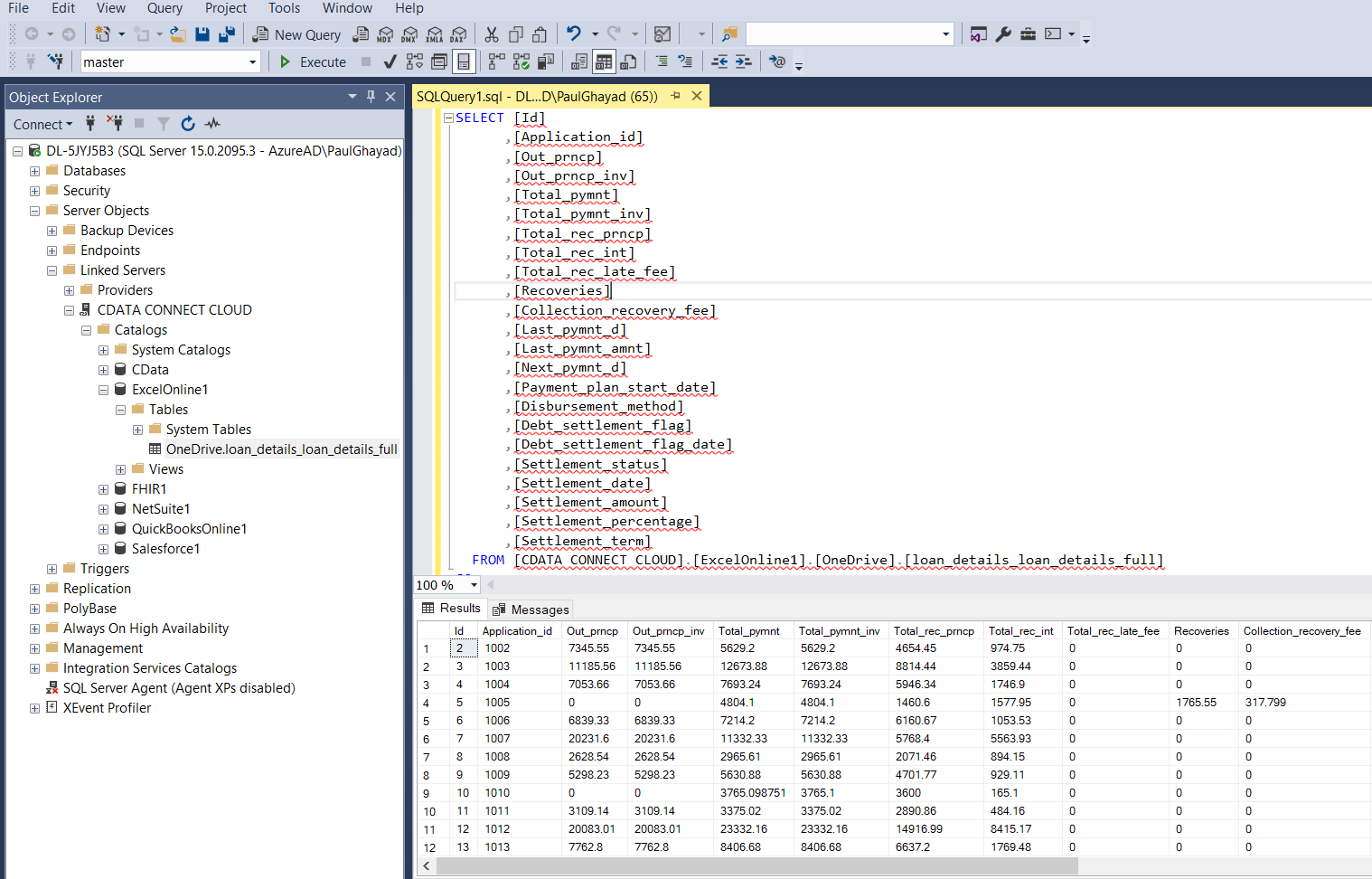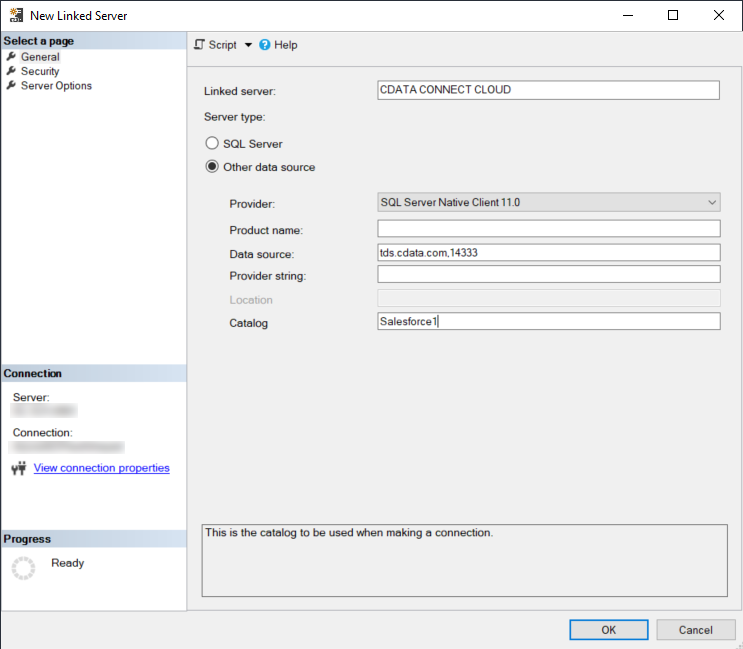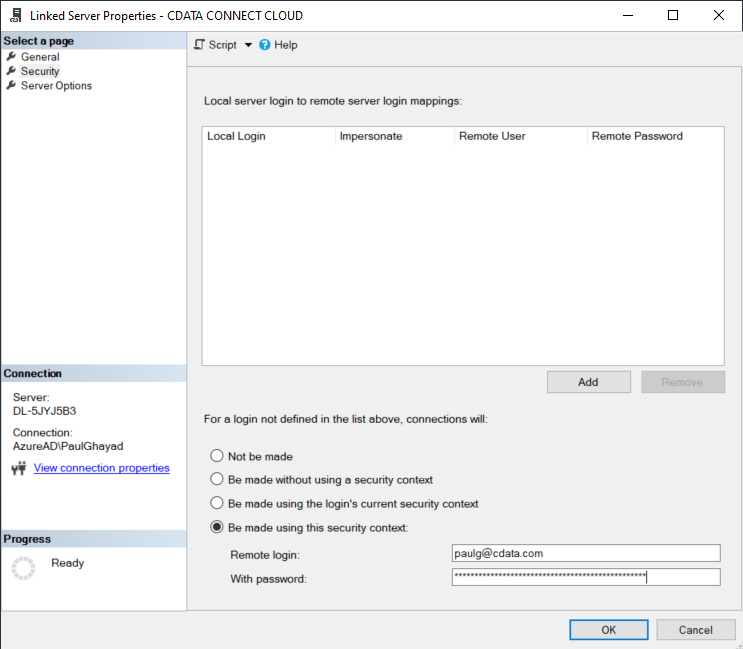Model Context Protocol (MCP) finally gives AI models a way to access the business data needed to make them really useful at work. CData MCP Servers have the depth and performance to make sure AI has access to all of the answers.
Try them now for free →Connect to Salesforce Data as a SQL Server Linked Server
Use CData Connect Cloud to create a linked server for live Salesforce data.
SQL Server Linked Servers enable the SQL Server Database Engine to read data from remote data sources and execute commands against the remote database servers outside of the instance of SQL Server. Typically, linked servers are configured to enable the execution of a T-SQL statement that includes tables in another instance of SQL Server, or another database product such as Oracle. When paired with CData Connect Cloud, linked servers provides instant access to Salesforce data from your SQL Server database. This article demonstrates how to connect to Salesforce using Connect Cloud and query Salesforce data in SQL Server Management Studio (SSMS).
CData Connect Cloud provides a pure SQL Server interface for Salesforce, allowing you to query data from Salesforce without replicating the data to a natively supported database. Using optimized data processing out of the box, CData Connect Cloud pushes all supported SQL operations (filters, JOINs, etc.) directly to Salesforce, leveraging server-side processing to return the requested Salesforce data quickly.
About Salesforce Data Integration
Accessing and integrating live data from Salesforce has never been easier with CData. Customers rely on CData connectivity to:
- Access to custom entities and fields means Salesforce users get access to all of Salesforce.
- Create atomic and batch update operations.
- Read, write, update, and delete their Salesforce data.
- Leverage the latest Salesforce features and functionalities with support for SOAP API versions 30.0.
- See improved performance based on SOQL support to push complex queries down to Salesforce servers.
- Use SQL stored procedures to perform actions like creating, retrieving, aborting, and deleting jobs, uploading and downloading attachments and documents, and more.
Users frequently integrate Salesforce data with:
- other ERPs, marketing automation, HCMs, and more.
- preferred data tools like Power BI, Tableau, Looker, and more.
- databases and data warehouses.
For more information on how CData solutions work with Salesforce, check out our Salesforce integration page.
Getting Started
Configure Salesforce Connectivity for SQL Server
Connectivity to Salesforce from SQL Linked Servers is made possible through CData Connect Cloud. To work with Salesforce data from SQL Linked Servers, we start by creating and configuring a Salesforce connection.
- Log into Connect Cloud, click Connections and click Add Connection
- Select "Salesforce" from the Add Connection panel
-
Enter the necessary authentication properties to connect to Salesforce.
There are several authentication methods available for connecting to Salesforce: Login, OAuth, and SSO. The Login method requires you to have the username, password, and security token of the user.
If you do not have access to the username and password or do not wish to require them, you can use OAuth authentication.
SSO (single sign-on) can be used by setting the SSOProperties, SSOLoginUrl, and TokenUrl connection properties, which allow you to authenticate to an identity provider. See the "Getting Started" chapter in the help documentation for more information.
![Configuring a connection (Salesforce is shown)]()
- Click Create & Test
-
Navigate to the Permissions tab in the Add Salesforce Connection page and update the User-based permissions.
![Updating permissions]()


Add a Personal Access Token
If you are connecting from a service, application, platform, or framework that does not support OAuth authentication, you can create a Personal Access Token (PAT) to use for authentication. Best practices would dictate that you create a separate PAT for each service, to maintain granularity of access.
- Click on your username at the top right of the Connect Cloud app and click User Profile.
- On the User Profile page, scroll down to the Personal Access Tokens section and click Create PAT.
- Give your PAT a name and click Create.
- The personal access token is only visible at creation, so be sure to copy it and store it securely for future use.

Connect to Salesforce from SQL Server using Connect Cloud
To establish a connection from SQL Server Linked Server to the CData Connect Cloud Virtual SQL Server API, follow these steps.
- Open Microsoft SQL Server Management Studio.
- In the Object Explorer pane, open Server Objects, right-click Linked Servers, and select New Linked Server.
-
The New Linked Server dialogue opens. On the General page, enter the following information:
- Enter a name for the server in the Linked server field.
- Select the radio button Other data source and select SQL Server Native Client 11.0 as the provider.
- In the Data source field, enter tds.cdata.com,14333
- In the Catalog field, enter enter the Connection Name of the CData Connect Cloud data source you want to connect to (for example, Salesforce1).
![Configuring the new linked server]()
-
Select the Security page. At the bottom, select the radio button labeled Be made using this security
context and enter the following information:
- Remote login - enter your CData Connect Cloud username. This is displayed in the top-right corner of the CData Connect Cloud interface. For example, test@cdata.com.
- With password - enter the PAT you generated on the Settings page.
![Entering credentials]()
- Click OK to create the server. Your linked server can now be used to access the data in the data source you specified. If you need to access data from more sources, create another linked server for each one.

Execute Queries
You can now execute queries to the Salesforce linked server from any tool that can connect to SQL Server.
An example SQL query would be:
SELECT * FROM [CDATA CONNECT CLOUD].[Salesforce1].[Salesforce].[Account]
 We have successfully created a linked server that allows us to query Salesforce data.
We have successfully created a linked server that allows us to query Salesforce data.
Get CData Connect Cloud
To get live data access to 100+ SaaS, Big Data, and NoSQL sources directly from your SQL Server database, try CData Connect Cloud today!





